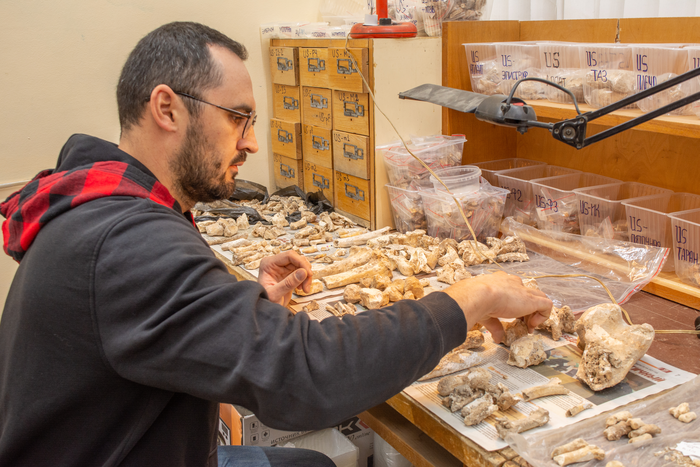A group of paleontologists, included researchers from the Ural Federal University (UrFU), discovered the jaws of an Etruscan bear from the early Pleistocene period (2–1.5 million years ago) in the Taurida cave. The remains of Etruscan bears (which is the ancestor of brown and cave bears) as part of the fauna of large mammals of the early Pleistocene were found in Western Europe, Asia, and North Africa. And now it is found in the Crimea. The bones indicate that the ancestor of modern man, the early Homo, most likely lived on the territory of the Crimean Peninsula almost 2 million years ago. The discovery was reported in the paleobiology journal Historical Biology.

Credit: UrFU / Anastasia Mavrenkova
A group of paleontologists, included researchers from the Ural Federal University (UrFU), discovered the jaws of an Etruscan bear from the early Pleistocene period (2–1.5 million years ago) in the Taurida cave. The remains of Etruscan bears (which is the ancestor of brown and cave bears) as part of the fauna of large mammals of the early Pleistocene were found in Western Europe, Asia, and North Africa. And now it is found in the Crimea. The bones indicate that the ancestor of modern man, the early Homo, most likely lived on the territory of the Crimean Peninsula almost 2 million years ago. The discovery was reported in the paleobiology journal Historical Biology.
“Our finding, on the one hand, extends the geography of distribution of the Etruscan bear in Eastern Europe, and on the other hand, it indicates that the “Crimean” bear is a link between Asian and European relatives. On the third hand, it helps to characterize the evolutionary features within the bears and the historical biogeography of this species,” said Dmitry Gimranov, senior researcher at the Laboratory of Natural Science Methods in the Humanities at UrFU.
Excavations by paleontologists were carried out in 2020–2021. The remains were found in the pre-surface layer of deposits of Taurida, in a small chamber called the “Hyena Den”. As a result of the research, it was established the features of life and the fact that the Etruscan bear coexisted next to such large predators as lynxes, giant hyenas, saber-toothed cats, wolves, with whom it had to compete for food resources just as it probably did with humans.
“More than 2 million years ago, together with the fauna of that time – antelopes, bulls, elephants, hyenas, Etruscan bears – the ancient man Homo moved towards Eurasia,” says Dmitry Gimranov. “As a rule, the presence of members of these faunas in the territories of Western Europe correlates with the presence of ancient Homo. The remains of ancient people have not yet been found in Taurida, most likely they were there, we just haven’t found them yet. But the structure of the Taurida’s fauna – Etruscan bear, saber-toothed tigers, hyenas and other large mammals – suggests that at that time the migration routes of ancient people could pass through this territory.”
The Etruscan bear was a typical representative of European faunas during the early Homo period, scientists believe. They concluded by comparing finds from the Taurida cave and its closest point with the same fauna of the same age Dmanisi (Georgia), where the earliest Eurasian Homo remains were found.
At the next stage of the work, paleontologists plan to study the food habits and ecological characteristics of the Etruscan bears. This will help to understand how they competed for food resources with other large predators.
Note
The Taurida Cave was discovered in Crimea in 2018. It is located 15 km east of Simferopol on the Inner Ridge of the Crimean Mountains. The bone layer of the cave corresponds to the fauna of Eastern Europe and the late Villafranchian of Western Europe (about 1.8–1.5 Ma). Taurida is rich in bones of early Pleistocene mammals. During two seasons of excavations, paleontologists found there the remains of the Issuar lynx, the skull of the giant hyena Pachycrocuta, and the bones of other ancient animals.
Journal
Historical Biology
DOI
10.1080/08912963.2022.2067993
Article Title
Ursus etruscus from the late Early Pleistocene of the Taurida сave (Crimean Peninsula)
Article Publication Date
12-May-2022




